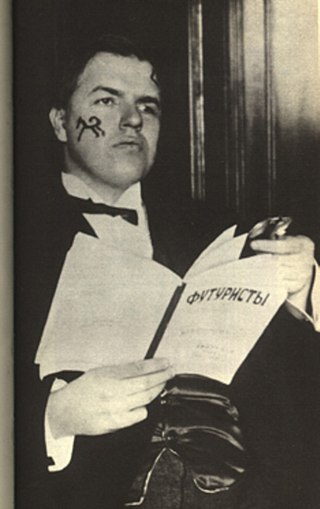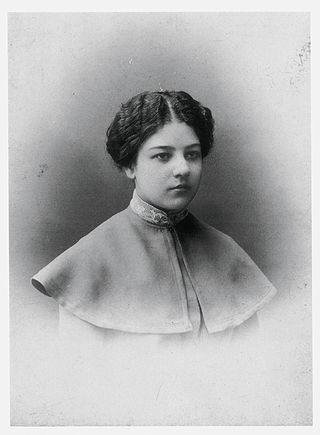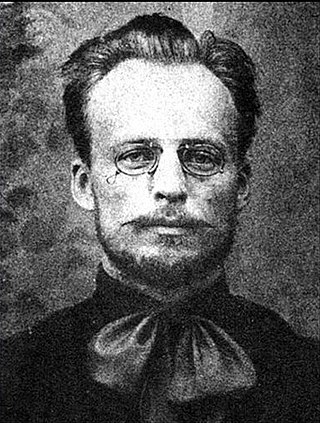Related Research Articles

Kazimir Severinovich Malevich was a Russian avant-garde artist and art theorist, whose pioneering work and writing influenced the development of abstract art in the 20th century. He was born in Kiev, to an ethnic Polish family. His concept of Suprematism sought to develop a form of expression that moved as far as possible from the world of natural forms (objectivity) and subject matter in order to access "the supremacy of pure feeling" and spirituality. Malevich is also sometimes considered to be part of the Ukrainian avant-garde that was shaped by Ukrainian-born artists who worked first in Ukraine and later over a geographical span between Europe and America.

Aleksandra Aleksandrovna Ekster, also known as Alexandra Exter, was a Russian and French painter and designer.

The Russian avant-garde was a large, influential wave of avant-garde modern art that flourished in the Russian Empire and the Soviet Union, approximately from 1890 to 1930—although some have placed its beginning as early as 1850 and its end as late as 1960. The term covers many separate, but inextricably related, art movements that flourished at the time; including Suprematism, Constructivism, Russian Futurism, Cubo-Futurism, Zaum, Imaginism, and Neo-primitivism. In Ukraine, many of the artists who were born, grew up or were active in what is now Belarus and Ukraine, are also classified in the Ukrainian avant-garde.

Cubo-Futurism or Kubo-Futurizm was an art movement, developed within Russian Futurism, that arose in early 20th century Russian Empire, defined by its amalgamation of the artistic elements found in Italian Futurism and French Analytical Cubism. Cubo-Futurism was the main school of painting and sculpture practiced by the Russian Futurists. In 1913, the term "Cubo-Futurism" first came to describe works from members of the poetry group "Hylaeans", as they moved away from poetic Symbolism towards Futurism and zaum, the experimental "visual and sound poetry of Kruchenykh and Khlebninkov". Later in the same year the concept and style of "Cubo-Futurism" became synonymous with the works of artists within Ukrainian and Russian post-revolutionary avant-garde circles as they interrogated non-representational art through the fragmentation and displacement of traditional forms, lines, viewpoints, colours, and textures within their pieces. The impact of Cubo-Futurism was then felt within performance art societies, with Cubo-Futurist painters and poets collaborating on theatre, cinema, and ballet pieces that aimed to break theatre conventions through the use of nonsensical zaum poetry, emphasis on improvisation, and the encouragement of audience participation.

Nina Henrichovna Genke [Hɛŋkə] or Nina Henrichovna Genke-Meller, or Nina Henrichovna Henke-Meller was a Ukrainian-Russian avant-garde artist,, designer, graphic artist and scenographer.

Vadym Heorhiiovych Meller was a Ukrainian and Soviet painter, avant-garde Cubist, Constructivist and Expressionist artist, theatrical designer, book illustrator, and architect. In 1925 he was awarded a gold medal for the scenic design of the Berezil Theatre in the International Exhibition of Modern Decorative and Industrial Arts in Paris.
Solomon Nikritin was a Ukrainian painter, avant-garde artist, philosopher, and author.

David Davidovich Burliuk was a Ukrainian poet, artist and publicist associated with the Futurist and Neo-Primitivist movements. Burliuk has been described as "the father of Russian Futurism."
Verbovka or Verbovka Village Folk Center was an artisan cooperative in the village of Verbovka founded by Natalia Davidova in the Ukrainian province of Kyiv. Natalia Davidova, one of the founders and the head of the Kyiv Folk Center, was an Avant-garde artist descended from the ancient Ukrainian Hudim-Levkovichis family. The beginning of the cooperation of Natalia Davidova and Nina Genke-Meller originated not just from their family relations. They both were keen on folk art and were devoted to the idea of implementation of Avant-garde artistic principles into practice of amateur goods. In 1915 Nina Genke became a head and chief artist of Natalia's Davidova Folk Center in Verbovka village. N.Davidova involved Nina Genke in "promoting " folk thing's production in accordance with the sketchers of famous Avant-garde artists. The members of the Supremus group started to cooperate very actively. Between 1915 and 1916 many Suprematist artists such as Kazimir Malevich, Aleksandra Ekster, Nina Genke-Meller, Nadezhda Udaltsova, Liubov Popova, Olga Rozanova, Ivan Puni, Ksenia Boguslavskaya, Ivan Kliun and others worked with peasant artisans at the cooperative. In November 1915 N.Davidova, together with A.Ekster and N.Genke, arranged an Exhibition of Modern Decorative Art of the South of Russia in Lamersie Moscow Gallery. There they represented the village ladies' works who studied decorative art in Verbovka and Skoptsi's schools, as well as carpets, pillows, shawls and belts made in accordance with sketches of Popova, Malevich, Davidova, Genke, Ekster, Puni, Kliun, Pribilskaya, Yakulov, Rozanova, Vasilieva, Boguslavskaya and others. The exhibition received broad publicity in the press. In 1917 Davidova and Genke arranged the Second Exhibition of Modern Decorative Art in Moscow in Mikhailava's Saloon.

Vladimir Davidovich Baranov-Rossiné, also spelled Baranoff-Rossiné, born Shulim Wolf Leib Baranov, was a painter and sculptor active in Russia and France. His work belonged to the avant-garde movement of Cubo-Futurism. He was also an inventor.

Olga Vladimirovna Rozanova was a Russian avant-garde artist painting in the styles of Suprematism, Neo-Primitivism, and Cubo-Futurism.
Supremus was a group of Russian avant-garde artists led by the "father" of Suprematism, Kazimir Malevich. It has been described as the first attempt to found the Russian avant-garde movement as an artistic entity within its own historical development.

Vladimir Davydovych Burliuk was a Ukrainian avant-garde artist and book illustrator from the Russian empire. He died at the age of 32 in 1917 in World War I.

Alexander Konstantinovich Bogomazov or Oleksandr Kostiantynovych Bohomazov was a Ukrainian painter, cubo-futurist, modern art theoretician and is recognised as one of the key figures of the Ukrainian avant-garde scene. In 1914, Oleksandr wrote his treatise The Art of Painting and the Elements. In it he analyzed the interaction between Object, Artist, Picture, and Spectator and sets the theoretical foundation of modern art. During his artistic life Oleksandr Bohomazov mastered several art styles. The most known are Cubo-Futurism (1913–1917) and Spectralism (1920–1930).

Victor Nikolaevich Palmov was a Russian and Ukrainian painter and avant-garde artist from the David Burliuk circle.
Kliment Nikolaevich Red'ko or Redko, 15 (27) October 1897 - 18 February 1956) was a Ukrainian-Russian painter-scientist, avant-garde artist, graphic artist.
Alexander (Oleksandr) Khvostenko-Khvostov was a Russian/Ukrainian/Soviet avant-garde artist (Constructivist), and stage designer.

Soyuz Molodyozhi was an artistic group and an art magazine of Russian avant-garde organized in 1910. There were more than 30 members of the group and most of other Russian avant-garde participated in their exhibitions.

Benedikt Konstantinovich Livshits was a poet and writer of the Silver Age of Russian Poetry, a French–Russian poetry translator.

Ukrainian avant-garde is the avant-garde movement in Ukrainian art from the end of 1890s to the middle of the 1930s along with associated artists in sculpture, painting, literature, cinema, theater, stage design, graphics, music, architecture. Some well-known Ukrainian avant-garde artists include: Kazimir Malevich, Alexander Archipenko, Vladimir Tatlin, Sonia Delaunay, Vasyl Yermylov, Alexander Bogomazov, Aleksandra Ekster, David Burliuk, Vadym Meller, and Anatol Petrytsky. All were closely connected to the Ukrainian cities of Kyiv, Kharkiv, Lviv, and Odesa by either birth, education, language, national traditions or identity. Since it originated when Ukaine was part of the Russian Empire, Ukrainian avant-garde has been commonly lumped by critics into the Russian avant-garde movement.
References
- ↑ Gaze, Delia (2001). Concise Dictionary of Women Artists. New York: Fitzroy Dearborn Publishers. p. 290. ISBN 978-1-57958-335-4.
- ↑ Makaryk, Irene Rima; Tkacz, Virlana (2010). Modernism in Kyiv: Kiev/Kyïv/Kiev/Kijów/?ie? : Jubilant Experimentation. Toronto: University of Toronto Press. p. 80. ISBN 978-1-4426-4098-6.
- ↑ Markov, Vladimir (1968). Russian Futurism: A History. Berkeley, CA: University of California Press. p. 37.